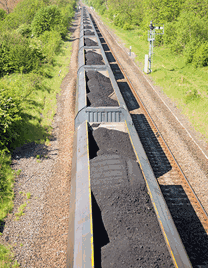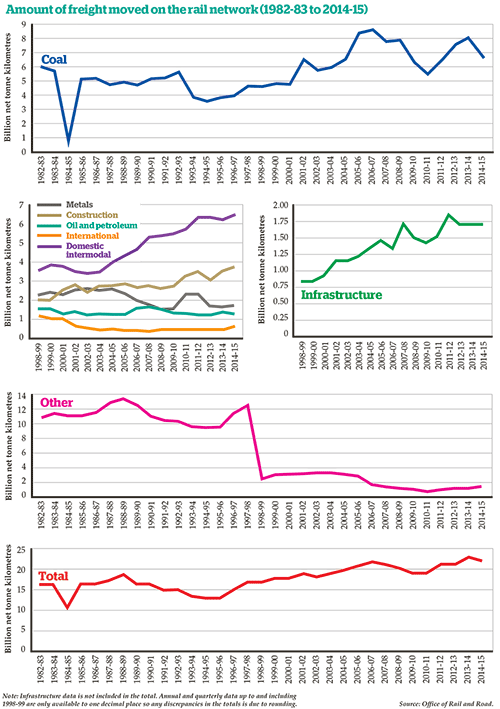 Read the peer review for this feature.
Read the peer review for this feature.
Download the graphs for this feature.
2016 beckons in a brave but rather chilly new world for rail freight. Coal, the backbone of the freight market since the very start of the Railway Era, has suffered a dramatic decline. Freight traffic moved by rail is down by 18%, the largest year-on-year fall since (ironically) the miner’s strike in 1984, when the problem was lack of production rather than lack of demand.
While doing their level best to accentuate the positive, the latest set of Office of Rail and Road statistics can’t escape the herd of elephants in the room, with coal leading the charge (down by 58%), followed by Channel Tunnel (down 32.5%), metals (down 15%) and petrochemicals (down 1%).
On the brighter, accentuate-the-positive side of things, the ORR points to “other” traffic (stuff that hasn’t been of sufficient interest to warrant disaggregation) increasing by 15%, construction rising by 1.6%, and domestic intermodal (the forecast source of most future growth) up by 0.4%.
While rail freight might temporarily be in the doldrums, there are always forecasts of jam tomorrow to fall back on. Trouble is, the history of the past 20 years reveals something of a discrepancy between forecast and actualité. Exhibit A shows the various forecasts made for and by the industry, against the comparative growth achieved by the industry itself over the same period (see Graph 1, page 37).
So either the forecasts are way off, the industry’s ability to deliver them is way off, or there is some other explanation. To be fair, the last set of forecasts produced for Network Rail in 2013 noted that these were “unconstrained” - not intellectually, but in terms of only showing the assumed latent potential of the railways to carry freight.
In the case of domestic intermodal, the approach has been to tot up every new rail freight interchange in the known universe, and to then suggest how many trains each one might produce according to the size of its warehousing, to arrive at an impressive forecast of potential new traffic. The actual evidence from the first generation of large rail freight interchanges (Daventry International Rail Freight Terminal, Hams Hall, etc) would tend to support the “build it and the trains will come” assumption.
If you then apply constraints, such as the (previously) ponderous planning process for delivering such interchanges, or the willingness of the end users to use rail, the ability of the operators to provide a competitive rail service, or the network to provide paths whenever they might be needed, the forecast will not be as high. That doesn’t need a degree in rocket science to understand, nor should it imply that imposing constraints will spell the end for rail freight as we know it.
As coal, steel and petrochemicals demonstrate, and the forecasts attempt to model, the economy does not stand still. The structure of industry and trade continues to change - sometimes cyclical (automotive manufacturing and railway passengers) and sometimes not (coal, thus far).
This is not to suggest that the entire rug has been pulled out from under the freight operating companies, just that there are now quite a few holes and bald patches that will need new material.
While we continue to build infrastructure, the construction sector will continue to use rail. And while we continue to make and/or consume general merchandise, there will be a market for moving them, a market that the rail freight industry has tended to lump together in the “other” category (assuming it’s either in a container or it’s not otherwise worth thinking about).
For the record, general merchandise (anything that doesn’t fit in the traditional bulk freight categories) amounts to nearly 700 million tonnes lifted by road haulage, or nearly half of all road haulage tonnage. Around a fifth of this tonnage moves more than 200 miles, bringing more than 130 million tonnes within rail’s target area of operation. Yet the forecasts assume that the current level of rail freight traffic (0.4 million tonnes, or 0.06% of the equivalent road market) will remain constant.
The assumption is that a good chunk of this ‘other’ stuff will find its way into a container and onto an intermodal service. Fair enough, and the continued (if shallowing) growth in intermodal rail freight over the past decade would endorse this. Yet the risk is that such a mindset closes off the possibility of unlocking any more of the general merchandise market (itself five times larger than the entire rail freight market) that can’t or won’t convert to containers. For example:
- Ports such as London Gateway, Liverpool Superport, Felixstowe SuperDuper Port and Teesport ÜberPort will all tell you that the future is port-centric - the shipping containers stay at the port and get de-stuffed in quayside warehousing, with the contents (rather than the containers) moved inland to customers. This view was endorsed recently in conversation with a leading road haulier, who acknowledged that given a choice between moving a container inland (which adds four tonnes of tare weight to the truck, so taking away four tonnes of revenue-earning payload) or moving the same goods inland in a standard truck or a conventional rail wagon, he wouldn’t need to phone a friend (or indeed a rocket scientist!) to work out which could be cheaper. His view is that rail-linked warehousing and conventional (or non-intermodal) rail services will become increasingly important, “despite people thinking it’s all a bit old-fashioned”.
- Ongoing separate discussions with (respectively) a major parcels carrier, a major supermarket and a major online retailer - all of which are looking for a much faster rail service than intermodal or standard conventional wagons (or indeed road haulage) could ever provide.












